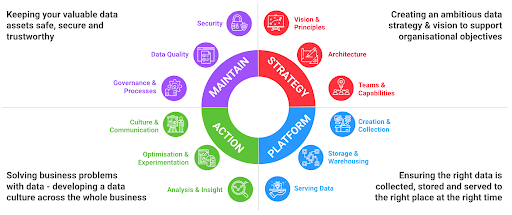Data
The SPAM framework: a tool for building better data strategies
01 October 2021 • 3 min read
.png?width=1920&height=836&name=The%20SPAM%20framework-%20a%20tool%20for%20building%20better%20data%20strategies%20(1).png)
The SPAM framework is a tool we developed at AND for clients who want to unlock more value from their data. But what is it? And how does it work?
We spoke to Head of Insight Tim Hatton to find out what it is and how it can be used to guide and inform data and insight strategies.
AND: Hi Tim! Thanks for talking. What is the SPAM framework?
Tim Hatton: The SPAM framework is AND’s model of the key capabilities required for an organisation to get value out of their data. There are 12 capabilities, split into four areas: Strategy, Platform, Action and Maintain - which pleasingly spells SPAM. We could have rearranged them to make MAPS or AMPS, but SPAM has stuck (and is a bit more memorable as a word).

A framework to guide data strategy
Why was it developed? What problems were you trying to tackle with it?
TH: Often companies have preconceived ideas that a problem with data can be fixed simply by implementing a new tool, or hiring data engineers, when often there are ‘hidden’ issues with a lack of data governance, or no overarching data vision.
We wanted a way to easily explain to clients all the holistic capabilities across a business which are important to consider when thinking about their use of data. This then allows them to consider areas related to successful use of data which they may not have thought about - or may not even exist within their organisation.
The framework has been through a number of iterations - originally we designed it as an end-to-end value chain, but over time it evolved away from a linear model to something which encompasses the whole of an organisation where there are dependencies everywhere.
Talk to us about how we can help you better leverage data. Learn more.
How we use the framework with clients
What role does it play in how you work with clients? Has it changed/helped how you work with them?
TH: All of our engagements cover some part of this framework - it might be that we’re just looking at some advanced analysis work, and showing the client how this work doesn’t sit in isolation. For example, being able to do advanced analysis needs trustworthy data which is easy to get to - which touches on the Maintain and Platform sections of the model.
Often, one of the first things we do with clients is a ‘health check’ of their data capabilities against the SPAM model. We’ll get them to rate where they think their maturity is against the model, and then we provide our own scoring after speaking with their teams and reviewing their set up. This then allows us to have some good conversations about where we agree on their assessment of their capabilities - and where we may differ.
Could you give an example of how you’ve used it out in the field?
TH: Identifying opportunity areas at the start of a data strategy - for a major UK news & media organisation we rated their data capabilities against the framework to identify where they should focus their efforts. We ran a number of workshops and interviews to put together a holistic view of how mature they were against the framework - and we also got our key stakeholders to do the same thing.
Are there any caveats when using it? Are there ways it can be misinterpreted or misused?
TH: As with any kind of analysis, context is everything. The size of a client, the industry the work in, the outcomes they’re looking for from data - all will affect how important any of the given capabilities are, and how much weight should be given to areas which might be rated low. The model is also designed to be flexible - we don’t focus on any specific technologies or skills but leave the detail in those areas to be filled in by the team.
Read next: Future trends in data engineering
Are there any other frameworks out there that inspired or guided you? If yes, what limitations do they have?
TH: Every data consultancy in the world has some kind of framework or value chain like this. We’re constantly reviewing our framework against others - our framework is designed to focus on a general capability rather than specific technologies which may go out of date.
Thanks Tim! To find out more about how we can help evolve your data capabilities head here.



